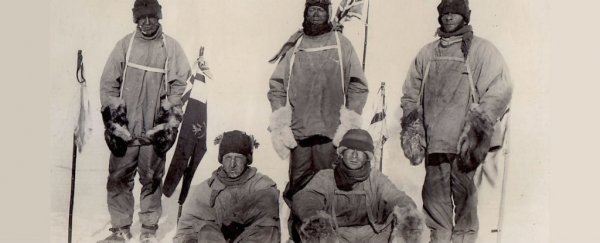Logbooks from the likes of Captain Robert Scott and Sir Ernest Shackleton - key figures in the 'Heroic Age' of Antarctic exploration - have revealed that sea ice levels in Antarctica have barely changed over the past century, despite global temperatures hitting record highs year after year.
That finding might seem counterintuitive, especially given that sea ice in the Arctic has never been so depleted. But it might actually help us explain one of the biggest mysteries surrounding climate change: how Antarctica appears to be thriving - and sometimes even expanding - despite all odds.
"The missions of Scott and Shackleton are remembered in history as heroic failures, yet the data collected by these and other explorers could profoundly change the way we view the ebb and flow of Antarctic sea ice," says lead researcher Jonathan Day from the University of Reading in the UK.
Day and his team examined observations of sea ice recorded in the official logbooks from 11 voyages that took place between 1897 and 1917, including three missions led by Captain Scott, two by Shackleton, and sea-ice records from French, German, and Belgian explorers.
These logbooks include observations of many environmental and meteorological phenomena, recorded several times a day throughout each mission by the explorers and their crew.
Many of the logbooks had been recently digitised as part of the International Comprehensive Ocean-Atmosphere Data Set initiative, but others were digitised especially for this study, and the information within was collated into a dataset of 191 observations of sea ice positions spanning two decades.
These observations were then compared to satellite data from 1989 to 2014, and other than the sea ice edge in the Weddell Sea declining by about 14 percent over the past century, the team found that ice conditions during the golden age of exploration were surprisingly similar to those in Antarctica today.
"The study is the first to calculate sea ice in the period prior to the 1930s, and suggests the levels in the early 1900s were between 3.3 and 4.3 million square miles (5.3 and 7.4 million square kilometres)," Sarah Knapton reports for The Telegraph.
Thanks to data previously collected by whaling vessels, we know that during the 1950s, sea ice increased much higher than these levels, but then experienced a steep decline that brought it back down to today's 6 million square kilometres.
That decline has been widely been attributed to human-caused climate change, but there was just one problem - despite the overall decline in recent decades, since the 1970s, we've also seen slight periodic increases that scientists can't explain.
Now that we have records from as far back as 1897 to go on, we can finally start to piece together what the hell has been going on with the Antarctic sea ice all this time.
What the records reveal is that Antarctic sea ice has been naturally fluctuating throughout the 21st century, transitioning between decades of high ice cover and decades of low ice cover, rather than a steady downward trend.
This suggests that Antarctic sea ice is much less sensitive to the effects of climate change than Arctic sea ice, which recently hit all-time lows, and has basically been doing its own thing for the past century.
"We know that sea ice in the Antarctic has increased slightly over the past 30 years, since satellite observations began. Scientists have been grappling to understand this trend in the context of global warming, but these new findings suggest it may not be anything new," says Day in a press statement.
"If ice levels were as low a century ago as estimated in this research, then a similar increase may have occurred between then and the middle of the century, when previous studies suggest ice levels were far higher."
But the fact that Antarctic sea ice doesn't appear to be as sensitive to climate change as Arctic sea ice shouldn't be an excuse for us to get complacent.
Recent observations of thousands of strange blue lakes appearing in Antarctica could be hinting at rapid disintegration of the ice sheet in the coming decades, because we've seen this kind of phenomenon in Greenland before - and with devastating results.
Day and his team now plan on tracking down new sources of historic records for Antarctica and Southern Ocean that surrounds it, to figure out more about its unique patterns and fluctuations, so we can do a better job at predicting what it might do in the future.
"The Southern Ocean is largely a ' black hole' as far as historical climate change data is concerned, but future activities planned to recover data from naval and whaling ships will help us to understand past climate variations and what to expect in the future," he said.
The research has been published in The Crysophere.
